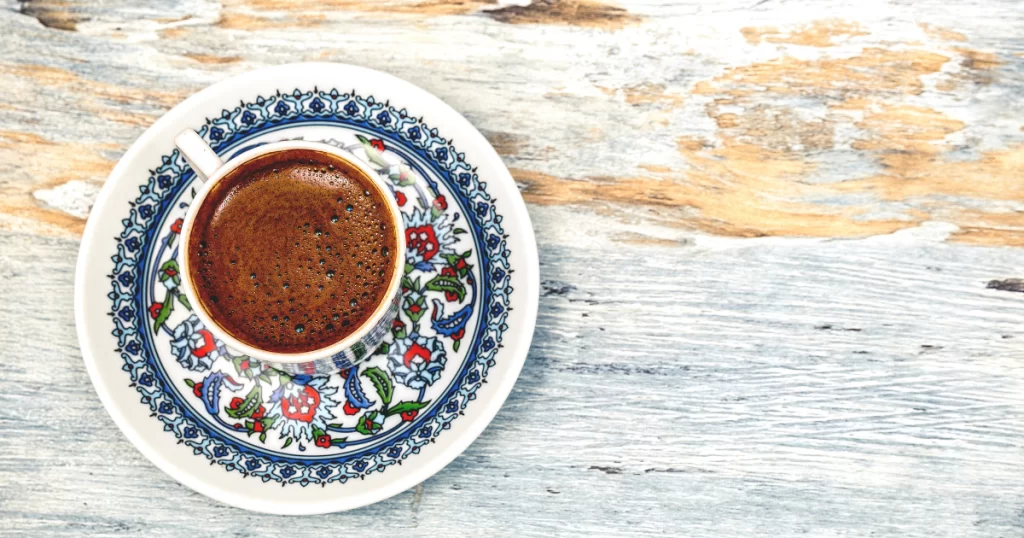Rich history, cultural significance, and mesmerizing flavors are characteristics that define Greek and Turkish coffee.
Even though these two brews are technically the same type of drink, there are still small but significant differences.
In this post, I will explain what those differences are and why some people may find it offensive if you misname their coffee.
Want to see why Turkish coffee is not your average brew? This article tells all.
What is the difference between Greek and Turkish coffee – Side-by-side comparison.
The only significant difference lies in the name. Greek coffee and Turkish coffee are essentially the same things.
The Greeks simply decided to give this beloved beverage its own name, distancing it from the long-standing cultural association with Turkey.
It’s important to note that despite the name change, the brewing process and the essence of the coffee remain virtually unchanged.
Both Greek and Turkish coffee is prepared by finely grinding roasted coffee beans into a fine powder.
Both use the same type of pot called ibrik or cezve to mix the water and coffee.
Both have distinctive foam, known as “kaimaki” in Greek and “kaymak” in Turkish.
When it comes to Greek coffee and Turkish coffee, the only true difference lies in the name.
How to prepare Greek and Turkish coffee?
The process itself is as important as the end result, as it symbolizes community, hospitality, and the art of slowing down in a fast-paced world.
- Add a cup of water (2-3 oz) to your pot, and add one teaspoon of coffee for each cup. You can add sugar now if you want sweeter coffee.
- Put your pot on the heat source and mix water, coffee, and sugar (if you added any) until everything is combined well.
- Make sure to set your heat to the lowest temperature and slowly bring the coffee to a boil.
- As the foam starts to rise, remove the pot from the heat source before it reaches the boiling point and pour it into the cup.

Pro tips you need to know
1. Choose quality coffee: The foundation of a remarkable cup of Greek or Turkish coffee begins with selecting high-quality coffee beans. Opt for a dark roast that has been finely ground to a consistency similar to powdered sugar.
2. Measure the Ingredients: For the best results, use the 1:10 coffee-to-water ratio. If you are adding 70 ml of water, add 7g of coffee.
3. Give it a try without sugar: Even though traditionally, people add sugar to Turkish and Greek coffee, I would recommend that at least once you try it without any sweaters to experience the real taste.
4. No stirring: After you mix all the ingredients at the beginning, don’t stir your coffee. Especially when the foam starts to rise.
Why do Greece and Turkey have the same coffee?
Despite their historical and political differences, these neighboring countries have a deep-rooted connection when it comes to their coffee culture. So, why is it that Greece and Turkey have the same coffee?
Historical legacy: You can trace the origins of Greek and Turkish coffee back to the Ottoman Empire. During the height of its power, the empire encompassed vast territories, including present-day Greece.
Geographical proximity: The physical proximity of Greece and Turkey has also contributed to the shared coffee culture. With their close proximity, it is only natural that traditions, including culinary practices, would overlap.
What other countries have coffee similar to Turkish?
Lebanese, Egyptian, Bosnian, Serbian, and Armenian coffee share similarities with Turkish coffee in terms of preparation, brewing in cezve-like pots, and often being served strong and sweetened, reflecting the rich coffee traditions of these cultures.
Arabic coffee is one more type of brew that is often mistaken for Turkish coffee. However, for this type of beverage, this is not true. Here you can find an explanation on what is the difference between Arabic coffee and Turkish coffee.
In conclusion
Despite the differences in name, the rituals, taste, and charm of these beverages remain the same, offering us a window into the rich and intertwined history of Greece and Turkey.
These delicious brews are not just about the caffeine kick but also the opportunity they provide to slow down and savor the moment.
My journey through renowned bars and coffee shops over five years, as a barista, coffee aficionado, and former bartender, has honed my pursuit for the perfect cup. My passion for coffee isn’t just about the brew—it’s about sharing the knowledge and insights I’ve gleaned along the way.



